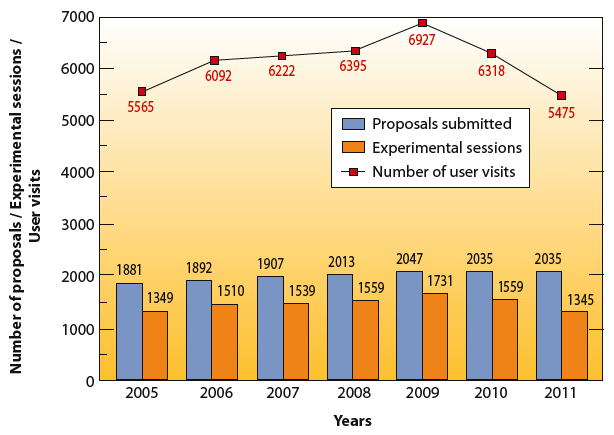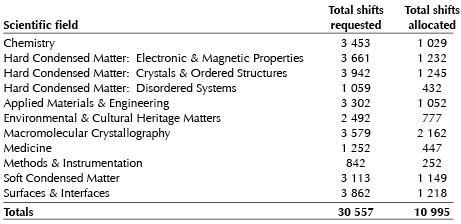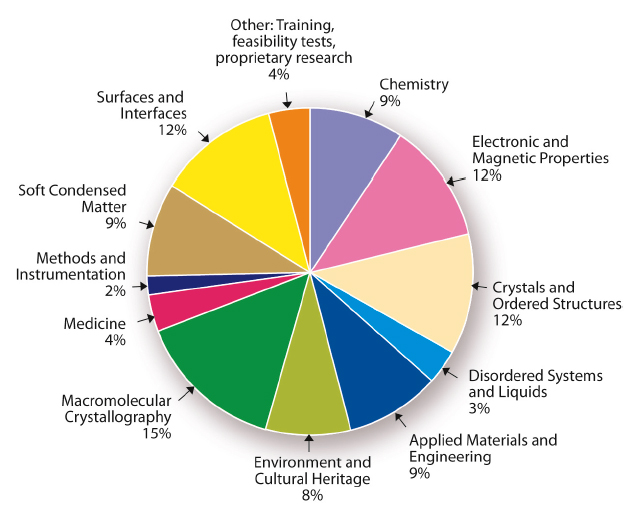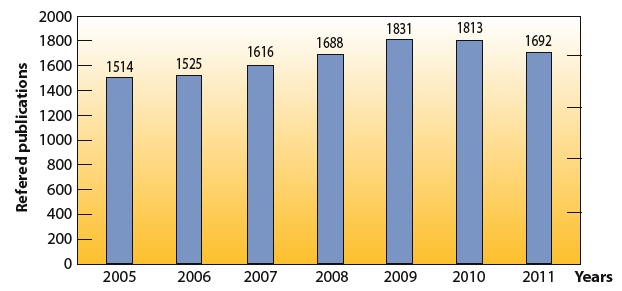User operation
After 17 years of successful operation of the facility for scientific Users, we look back on user operation over the year 2011, during which we saw further beamline upgrade works and, notably, the beginning of the first ever “long shutdown” since the ESRF began user operation back in 1994. The shutdown of the ESRF accelerator and beamlines from Monday 5th December is for a 5-month period during which the construction works for the new EX2 experimental hall extension will commence. As a consequence of this, the total beamtime available for 2011 was reduced by 20% compared with previous years. The early part of 2011 also saw the closure of one and a half beamlines (ID20 and BM05) to the public, while at the end of the year ID32 was also closed and BM16 ceased operation as a Spanish CRG beamline. Within the Upgrade Programme, the EXAFS beamline ID24 was closed for upgrade whilst BM23 re-opened to full operation for 2011. As soon as the beam was stopped in December, work began on several more Upgrade Beamline projects including the rebuilding of ID10A/B/C as one beamline complex ID10, the move of ID16 to ID20 and the move of ID14-3 to BM29. In total, 29.5 ESRF publicly funded beamlines and 9.5 CRG beamlines were available for users in 2011. Figure 166 shows the number of applications for beamtime received since 2005. Since the beginning of the Upgrade Programme work in 2010, the number of applications received has evened off due to the unavailability of some beamlines undergoing upgrade and the closure of others. Despite this, there has been no decrease in the number of proposals received and it is therefore evident that the number of proposals received per operating beamline continues to increase.
|
|
|
Fig. 166: Numbers of applications for beamtime, experimental sessions and user visits, 2005 to 2011. |
Proposals for experiments are selected and beamtime allocations are made through peer review. Review Committees of specialists, for the most part from European countries and Israel, have been set up in the following scientific areas:
- chemistry
- hard condensed matter: electronic and magnetic properties
- hard condensed matter: crystals and ordered systems
- hard condensed matter: disordered systems and liquids
- applied materials and engineering
- environmental and cultural heritage matters
- macromolecular crystallography
- medicine
- methods and instrumentation
- soft condensed matter
- surfaces and interfaces.
The Review Committees met twice during the year, around six weeks after the deadlines for submission of proposals (1 March and 1 September). They reviewed 2035 applications for beamtime, and selected 778 (38.2%), which were then scheduled for experiments.
The principle feature of this period was the difficulty faced by reviewers in deciding which proposals should be recommended for beamtime during the second half-year scheduling period; in this period only 60% of the usual beamtime was available and a similar number of proposals were received as in the previous year. Consequently only 32% of submitted proposals could be accepted for this scheduling period (compared to ~46% in previous years), and competition for the available beamtime was fierce.
Requests for beamtime, which is scheduled in shifts of 8 hours, totalled 30 557 shifts or 244 456 hours in 2011, of which 10 995 shifts or 87 960 hours (36.0%) were allocated. The distribution of shifts requested and allocated, by scientific area, is shown in Table 8.
|
|
|
Table 8: Number of shifts of beamtime requested and allocated for user experiments, year 2011. |
The breakdown of shifts scheduled for experiments by scientific area in the first half of 2011 is shown in Figure 167. The full year 2011 saw 5475 visits by scientists to the ESRF under the user programme, to carry out 1345 experiments; the number of users in each experimental team averaged just over 4 persons while the average duration of an experimental session was 9 shifts. This can be further broken down to show an average duration of 3 shifts for MX experiments and 14.5 shifts for non-MX experiments. The annual number of experimental sessions and user visits since 2005 is shown in Figure 166. The particularly high figures in 2009 are mainly due to the fact that an extra week of beam time was made available to users during that year to compensate partly for the anticipated reduction in beam time available in later years following the start of the reconstruction work of the Upgrade Programme. The effect of the reduction in beamtime available in 2011 due to the long shutdown is clearly visible in the lower-than-normal numbers of experimental sessions carried out and user visits.
|
|
|
Fig. 167: Shifts scheduled for experiments, March to July 2011, by scientific area. |
One of the principle measurable output parameters of the ESRF is the number and quality of publications accepted in peer-reviewed journals. Figure 168 shows how this number has been rising continuously over the past years, with a publication output systematically on a level of one publication per experimental session and reaching record numbers of more than 1800 for the years 2009 and 2010. The year 2011 promises to be equally fruitful, with 1692 publications already registered in the ILL/ESRF Library database. Since the ESRF began user operation back in 1994, a total of 19396 publications have been accepted in peer-reviewed journals. Of these, more than 200 every year are published in high impact factor journals.
|
|
|
Fig. 168: Numbers of publications appearing in refereed journals, 2005 to 2011. |
User responses to questionnaires show once again that the ESRF continues to maintain its excellent reputation concerning the assistance and service given by scientists and support staff on beamlines, and travel and administrative arrangements, in addition to the quality both of the beam and of the experimental stations. Facilities on site, such as preparation laboratories, the Guesthouse and a canteen open 7 days a week, also make an important contribution to the quality of user support.







